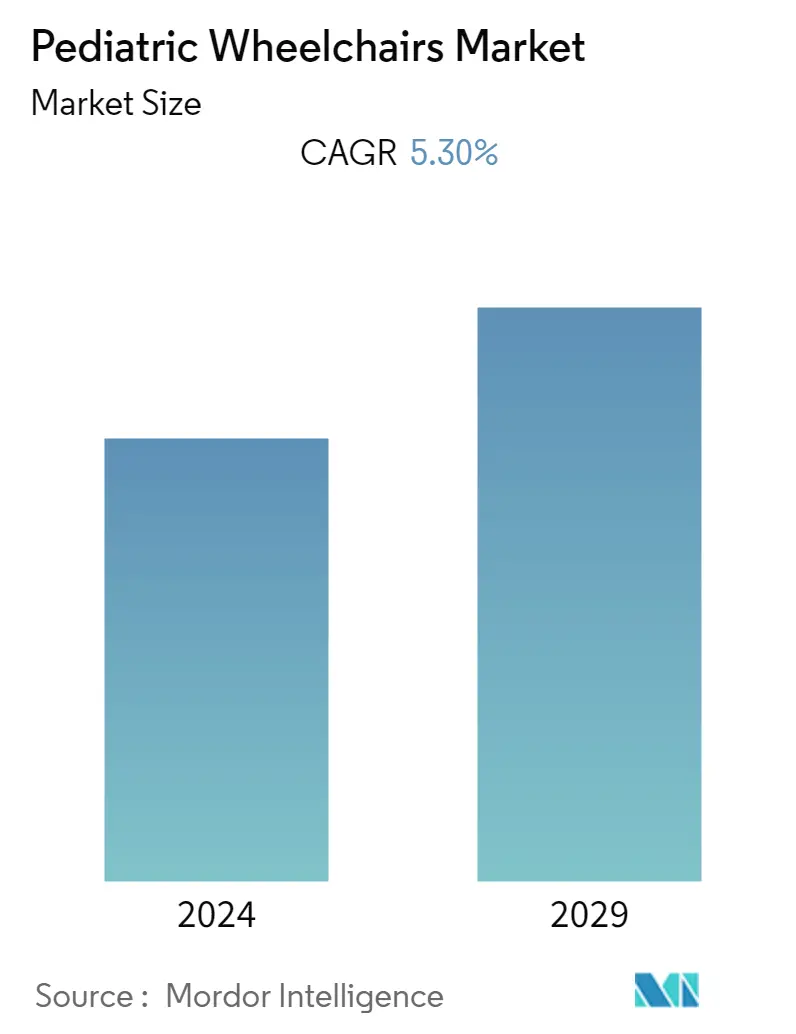Market Size of Pediatric Wheelchairs Industry

| Study Period | 2019 - 2029 |
| Base Year For Estimation | 2023 |
| CAGR | 5.30 % |
| Fastest Growing Market | Asia Pacific |
| Largest Market | North America |
| Market Concentration | Medium |
Major Players
*Disclaimer: Major Players sorted in no particular order |
Pediatric Wheelchairs Market Analysis
The pediatric wheelchairs market is projected to register a CAGR of 5.3% during the forecast period.
Wheelchair operations were halted in several countries as a result of the COVID-19 restrictions. Children with disabilities were particularly vulnerable to the Covid-19 outbreak and so had to stay at home. The disruption of the supply chain and logistics had an impact on businesses' sales revenue and profit. There was a decline in the demand for wheelchairs during the pandemic. However, the market recovered in the last two years since the restrictions were lifted. The market is expected to register stable growth during the forecast years owing to the category's continued advancement, expanding adoption, and the availability of a wide range of products.
The major factor attributing to the growth of the market is the increasing incidences of disabilities in children. According to United Nations International Children's Emergency Fund (UNICEF), data updated in 2022, 50% of the world's population which is at least one billion people have some form of disability, whether present at birth or acquired later in life. The number of children with disabilities globally was estimated at almost 240 million in 2021. Thus, the high number of disabled children are expected to boost the demand for pediatric wheelchair and are expected to propel the market growth.
Furthermore, according to the Juvenile Arthritis Foundation Australia 2022 report, juvenile arthritis is estimated to affect 6,000 to 10,000 Australian children aged 1-16 years, making it as common as childhood diabetes and epilepsy. Also, as per the Arthritis Foundation 2022 report, nearly 300 thousand children in the United States had juvenile arthritis in 2022. 36% of the surveyed children reported severe discomfort significantly limiting their daily activities. The large number of pediatric patients affected by arthritis require wheelchairs allowing comfortable movement, which is expected to propel the growth of the pediatric wheelchair market.
In addition, other diseases such as multiple sclerosis, epilepsy, and severe asthma in children require wheelchairs, boosting the demand during the forecast period. For instance, a retrospective study published in the Journal of Clinical Medicine in December 2022 stated that the overall crude prevalence of Paediatric-Onset Multiple Sclerosis in Poland's children population was 4.71 per 100,000 children. Children with MS have blurry vision or other changes in vision, numbness, and loss of balance or coordination. As per the data from Lung India as of August 2022, the prevalence of Asthma among Indian children was around 18.2%. The high burden of such diseases requires wheelchairs at home or hospitals, thereby propelling the market growth during the forecast period.
Therefore, owing to the factors such as the high burden of pediatric diseases restricting movement in children, the studied market is anticipated to witness growth over the analysis period. However, the high cost of wheelchairs especially in developing countries, where poverty and disability go hand in hand, acts as the major drawback for the market growth.
Pediatric Wheelchairs Industry Segmentation
As per the scope of the report, physical disability in children is caused due to spinal injury, cerebral palsy, spinal Bifida, etc. Pediatric wheelchairs need to be highly adjustable to the needs of a growing child and must be easy to adapt to the ever-changing needs of children. The Pediatric Wheelchairs Market is segmented by Product Type (Manual and Powered), Frame Type (Rigid Wheelchairs, and Foldable Wheelchairs), End User (Hospitals, Homecare Settings, and Other End Users), and Geography (North America, Europe, Asia-Pacific, Middle East and Africa, and South America). The market report also covers the estimated market sizes and trends for 17 different countries across major regions, globally. The report offers the value (in USD million) for the above segments.
| By Product Type | |
| Manual | |
| Powered |
| By Frame Type | |
| Rigid Wheelchairs | |
| Foldable Wheelchairs |
| By End User | |
| Hopsitals | |
| Homecare Setting | |
| Other End Users |
| Geography | ||||||||
| ||||||||
| ||||||||
| ||||||||
| ||||||||
|
Pediatric Wheelchairs Market Size Summary
The pediatric wheelchairs market is poised for stable growth over the forecast period, driven by the increasing prevalence of disabilities among children globally. The market experienced a temporary setback during the COVID-19 pandemic due to supply chain disruptions and reduced demand, but has since rebounded. The rising incidence of conditions such as juvenile arthritis, multiple sclerosis, and severe asthma necessitates the use of wheelchairs, thereby fueling market expansion. The demand for manual pediatric wheelchairs is particularly strong due to their affordability, lightweight nature, and ease of use, which are appealing features for both caregivers and patients. Additionally, advancements in pediatric wheelchair design and functionality are expected to further stimulate market growth.
North America is anticipated to lead the pediatric wheelchairs market, supported by a robust healthcare infrastructure and a high prevalence of physical disabilities among children. The presence of major market players and significant investment in research and development also contribute to the region's dominance. The market is moderately competitive, with key players like Ottobock, MEYRA GmbH, and Sunrise Medical actively participating. Innovations such as adjustable wheelchairs that grow with the child are being introduced, enhancing the market's appeal. Despite challenges such as high costs in developing regions, the overall outlook for the pediatric wheelchairs market remains positive, with continued growth expected in the coming years.
Pediatric Wheelchairs Market Size - Table of Contents
-
1. MARKET DYNAMICS
-
1.1 Market Overview
-
1.2 Market Drivers
-
1.2.1 Rising Incidences of Disabilities in Children
-
1.2.2 Supportive Government Policies and Funding
-
-
1.3 Market Restraints
-
1.3.1 High Cost of Paediatric Wheelchairs
-
-
1.4 Porter's Five Forces Analysis
-
1.4.1 Threat of New Entrants
-
1.4.2 Bargaining Power of Buyers/Consumers
-
1.4.3 Bargaining Power of Suppliers
-
1.4.4 Threat of Substitute Products
-
1.4.5 Intensity of Competitive Rivalry
-
-
-
2. MARKET SEGMENTATION (Market Size by Value - USD million)
-
2.1 By Product Type
-
2.1.1 Manual
-
2.1.2 Powered
-
-
2.2 By Frame Type
-
2.2.1 Rigid Wheelchairs
-
2.2.2 Foldable Wheelchairs
-
-
2.3 By End User
-
2.3.1 Hopsitals
-
2.3.2 Homecare Setting
-
2.3.3 Other End Users
-
-
2.4 Geography
-
2.4.1 North America
-
2.4.1.1 United States
-
2.4.1.2 Canada
-
2.4.1.3 Mexico
-
-
2.4.2 Europe
-
2.4.2.1 Germany
-
2.4.2.2 United Kingdom
-
2.4.2.3 France
-
2.4.2.4 Italy
-
2.4.2.5 Spain
-
2.4.2.6 Rest of Europe
-
-
2.4.3 Asia-Pacific
-
2.4.3.1 China
-
2.4.3.2 Japan
-
2.4.3.3 India
-
2.4.3.4 Australia
-
2.4.3.5 South Korea
-
2.4.3.6 Rest of Asia-Pacific
-
-
2.4.4 Middle East and Africa
-
2.4.4.1 GCC
-
2.4.4.2 South Africa
-
2.4.4.3 Rest of Middle East and Africa
-
-
2.4.5 South America
-
2.4.5.1 Brazil
-
2.4.5.2 Argentina
-
2.4.5.3 Rest of South America
-
-
-
Pediatric Wheelchairs Market Size FAQs
What is the current Pediatric Wheelchairs Market size?
The Pediatric Wheelchairs Market is projected to register a CAGR of 5.30% during the forecast period (2024-2029)
Who are the key players in Pediatric Wheelchairs Market?
Ottobock, MEYRA GmbH, Sunrise Medical, SORG Rollstuhltechnik GmbH and Invacare are the major companies operating in the Pediatric Wheelchairs Market.

